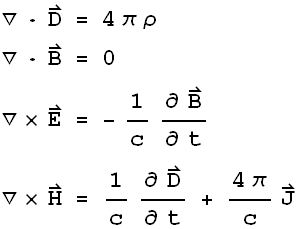
Recently the journal Physics World surveyed its readership about the greatest equations ever. In third place was Newton's 2nd Law:
F = m a
You may wish to know that the "winner" was a set of 4 equations explicitly unifying electricity and magnetism. They are usually called Maxwells' Equations. Just for interest, here they are:
Number 2 was Euler's amazing relation:
You may read more about this at http://physicsweb.org/articles/world/17/10/2/1.
The test format has been finalised. It consists of 2 parts:
You must bring your student card and a soft-lead pencil to the test.
You may bring a single 8 1/2 by 11 inch sheet of paper on which you have written anything that you wish. Both sides are OK, but it must be hand written.
You may bring a calculator that does not have text storage or communication capability.
| The test locations are available from the PHY138 home page. As a convenience, the button to the right links to the appropriate section of that page. |
We think the In-Class Questions have been quite successful on a number of levels. In our recent survey 78% of you rated them as positive in terms of their effectiveness. However, we think that they would be even more effective if we could get all of you to vote on your answer to a question at once instead of asking "How many think the answer is ...", then "How many of you think that instead the answer is ..." Thus we have prepared sets of 5 cardboard squares: each square is a different color and has a number between 1 and 5 printed on it. They are being distributed this week in tutorials. If you do not receive your set, see your tutor.
In the future, when asked an In-Class Question you will all raise the cardboard square that corresponds to your idea of the right answer.
Beginning on Monday November 8 please bring your set to each and every class. This is the first class of the Waves unit of PHY138, and you and Dr. Harlow will be using them in every class. |
We still have a few tutors who have not turned in the results of the survey. Thus the figure of 78% above is preliminary. We will make the full results available when we have them.
After today's class a student reported that the posted solution to Question 10.15 of the current Written Homework assignment is incorrect. She was correct. We will have a corrected version posted soon. Meanwhile, the answer is:
small, solid, light wheels.
|
||
The above photographs are of Amin, a PHY138 student from last year, serving a tennis ball. |
In order to maximise the speed of the serve, Amin needs to get the part of the racket that contacts the ball going at the highest possible speed. He does this with four lever arms:
Note that at contact, all four of these levers are at the maximum values as he "uncoils" into the serve. For each, the speed is given by:
r
where the angular speeds and radii are different numbers for each of the four rotations.
Thus the speed of the racket as it contacts the ball is as large as possible.
When Amin and I were first thinking about tennis serves we thought that it should be analysed in terms of the torques. Recently we convinced ourselves it is the speed of the racket that counts. That is why we are discussing this example at this late date instead of, say, Class 11 when we began discussing rotational motion. Also, Amin and I only thought about the last three lever arms above. A current PHY138 student pointed out the lever arm about the wrist after today's class; thanks!
We realised that the torque ![]() has the same role to play in angular motion that force does for translational motion. Similarly, the rotational analog of the momentum p is the angular momentum L. Thus, we have added 2 entries to our table of Translational-Rotational Analogs:
has the same role to play in angular motion that force does for translational motion. Similarly, the rotational analog of the momentum p is the angular momentum L. Thus, we have added 2 entries to our table of Translational-Rotational Analogs:
Translational Quantity |
Rotational Equivalent |
|---|---|
r |
|
v |
|
a |
|
m |
I = |
F |
|
p |
L = r x p = I |
| |